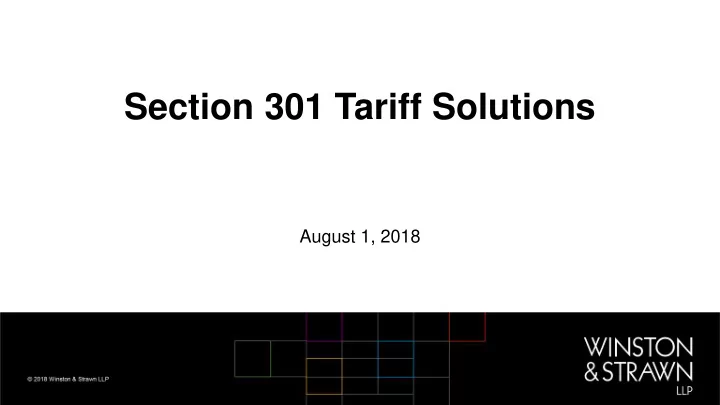

Section 301 Tariff Solutions August 1, 2018
Today’s Presenters Tom Jarvis Francesca Guerrero Chair, U.S. International Of Counsel Trade Commission Practice International Trade Washington, D.C. Compliance tjarvis@winston.com Washington, D.C. fguerrero@winston.com 2
Background Section 301 Investigation • Initiated at the request of the President on August 18, 2017 • Report issued by USTR on March 22, 2018 • Found that China’s acts, policies, and practices related to technology transfer, IP, and innovation burden or restrict U.S. commerce. • President directed various measures in response • WTO case • Investment restrictions • Additional Duties Currently no end date to the additional duties 3
Global Market Imbalances Canada Billions of US$ (2015) 302 281 China EU 484 430 273 116 Germany 125 303 325 50 Import Export Mexico 4
Three Tariff Lists First 25% List • Original list published in April covered more than 1,300 tariff lines • Targeted “Made in China 2025” products • After public comment the list was whittled down to 818 tariff lines • Effective July 6, 2018 Second 25% List (potential) • Original list published in June covered more than 280 tariff lines • Public comment period which closed July 23 Third 10% List (potential) • Triggered by Chinese retaliatory tariffs and more broad • Original list published in July covered more than 6,000 tariff lines • Public comment period closes Aug. 17 5
Solutions to Section 301 Tariffs Review Classification of Products Oppose Inclusion of HTSUS Classifications in Tariff Lists Seek Exclusion of Specific Products from Additional Duties Alternative Supply Chains End – To – End Solutions 6
Proper Classification of Products Review Primary HTSUS Classification • Is it correct? • Expert HTSUS classification review Investigate Special HTSUS Classifications • Review for reduced or zero tariff classifications • Nairobi exemptions for handicap products Legal Opinion re Appropriate HTSUS Classifications or Customs Ruling • Possible Part 117 rulings & appeals 7
Q/A re Tariff Classifications? 8
Oppose Inclusion of HTSUS Classification Only the 10% list is still open for public comment • Comment deadline is Aug. 17, 2018 Issues/Factors • Harm to U.S. businesses • Harm to U.S. consumers • Can the product be obtained from another country? • Relationship of HTSUS Classification to Section 301 Issues Business Confidential Information can be redacted There is a period for response to public comment 10
Seek Exclusion of Specific Products Standing to Submit Requests • Notice says US stakeholders, but foreign companies may submit Requests for items currently subject to tariffs due by Oct. 9 • Other timelines not yet released Issues/Factors • Whether the particular product is available only from China • Severe economic harm to the requestor or other U.S. interests • Whether the particular product is strategically important or related to “Made in China 2025” or other Chinese industrial programs 11
Seek Exclusion of Specific Products Exclusion will apply to the product, regardless of importer Opportunity for Others to Respond • The public will have 14 days to file responses • After the close of the 14 day response period, interested persons will have an additional 7 days to reply Retroactive Application & Refunds • Exclusions will be effective for one year from date of publication of exclusion • Retroactive to date tariffs applied (July 6 in case of current items) 12
Q/A re Tariff Comment or Product Exemption Process? 13
Changes to Supply Chain Manufacture by Chinese Affiliates Outside China • Does your current manufacturer have facilities outside of China? • Products manufactured in Hong Kong and Taiwan are not considered Chinese origin Manufacture by Others Outside China • Is it cheaper to switch manufacturers? Import Parts and Assemble in the United States • Requires determining the parts are not themselves subject to additional tariffs Changes to Supply Chain require careful scrutiny to ensure that the country of origin is not still China • Substantial transformation critical test 14
Retaliatory Chinese Tariffs Imposed in response to the July 6th tariff increase Asymmetrical – Only about 10% of the impact of the Section 301 tariffs Includes tariffs on more than 500 items, including: • Soybeans • Electric Vehicles • Seafood • Pork 15
Possible Negotiated Solutions China Objectives • Support Chinese enterprises • Access to USA markets—largest & most profitable USA Objectives • Incentivize China to end non-tariff international trade policies • Foreign companies required to have Chinese partner to operate in China • Mandatory technology transfers • Incentivize China to suppress IP theft • Rampant IP infringement • Cybersecurity • More equitable balance of trade 16
End-to-End Solutions International Trade • Exclusions of HTSUS classifications & exclusion of specific products • Supply chain • Chinese tariffs Corporate • Reorganization / restructuring if low cost supply model compromised • Relocate inventories outside USA to defer duties • Divest Chinese operations Finance • Bridge financing for short term tariff costs if trade dispute resolved Tax • Deductibility of tariff payments • Import Chinese components for assembly in USA • Shift importation activity to companies in need of tax deduction 17
Action Items • Aug. 17, 2018: Deadline re comments on the third tariff list • Oct. 9, 2018: Deadline re product exclusion requests on first list • Deadlines TBD for exclusion request on second and third tariff lists • Brief management re Section 301 tariff exposure & solutions • Financial planning for possible long term tariff costs • Tax planning 18
Questions?
Contacts Thomas L. Jarvis Chair, ITC Practice Winston & Strawn LLP 1700 K Street, NW Washington, D.C. 2006 Direct Dial:+1.202.282.5324 Email: TJarvis@Winston.com Francesca M.S. Guerrero Of Counsel International Trade Compliance Winston & Strawn LLP 1700 K Street, NW Washington, D.C. 2006 Direct Dial:+1.202.282.5337 Email: Fguerrero@Winston.com 21
Recommend
More recommend